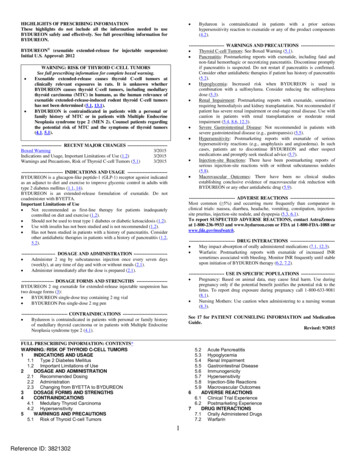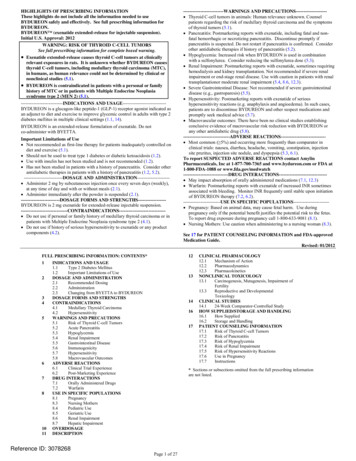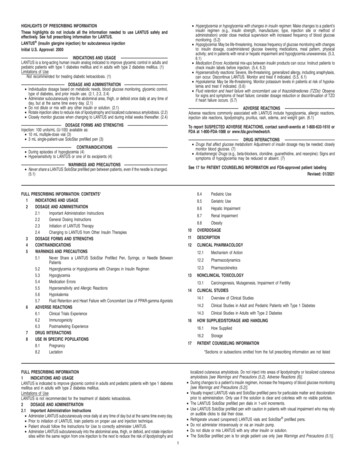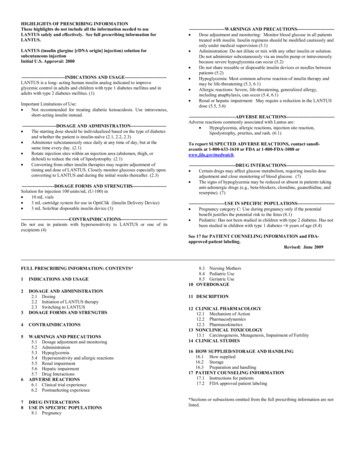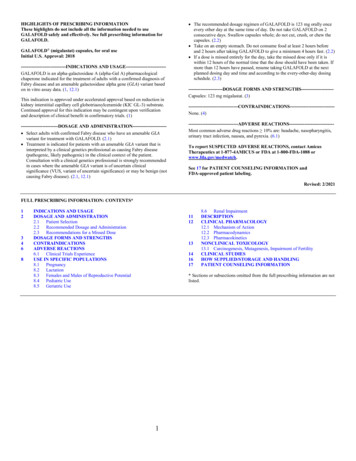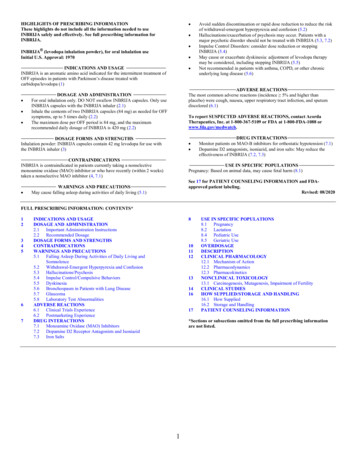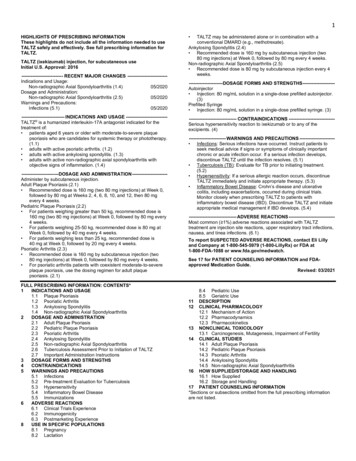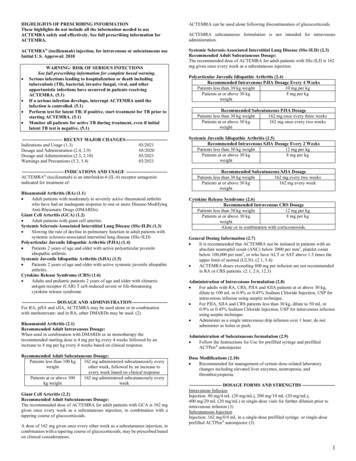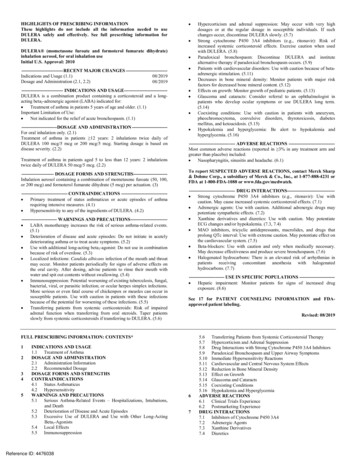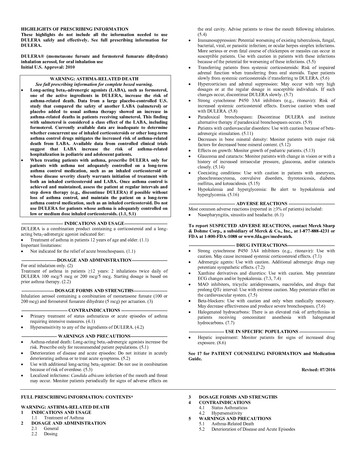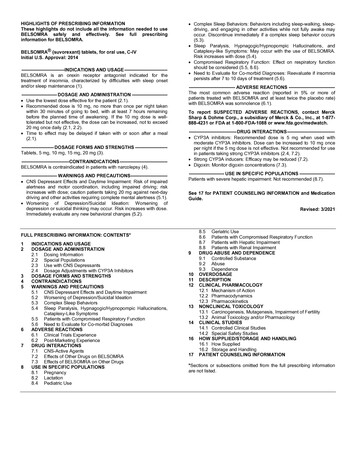
Transcription
HIGHLIGHTS OF PRESCRIBING INFORMATIONThese highlights do not include all the information needed to useBELSOMRA safely and effectively. See full prescribinginformation for BELSOMRA.BELSOMRA (suvorexant) tablets, for oral use, C-IVInitial U.S. Approval: 2014----------------------------INDICATIONS AND USAGE ---------------------------BELSOMRA is an orexin receptor antagonist indicated for thetreatment of insomnia, characterized by difficulties with sleep onsetand/or sleep maintenance (1).----------------------- DOSAGE AND ADMINISTRATION ---------------------- Use the lowest dose effective for the patient (2.1). Recommended dose is 10 mg, no more than once per night takenwithin 30 minutes of going to bed, with at least 7 hours remainingbefore the planned time of awakening. If the 10 mg dose is welltolerated but not effective, the dose can be increased, not to exceed20 mg once daily (2.1, 2.2). Time to effect may be delayed if taken with or soon after a meal(2.1).--------------------- DOSAGE FORMS AND STRENGTHS --------------------Tablets, 5 mg, 10 mg, 15 mg, 20 mg NS ------------------------------BELSOMRA is contraindicated in patients with narcolepsy (4).----------------------- WARNINGS AND PRECAUTIONS----------------------- CNS Depressant Effects and Daytime Impairment: Risk of impairedalertness and motor coordination, including impaired driving; riskincreases with dose; caution patients taking 20 mg against next-daydriving and other activities requiring complete mental alertness (5.1). Worsening of Depression/Suicidal Ideation: Worsening ofdepression or suicidal thinking may occur. Risk increases with dose.Immediately evaluate any new behavioral changes (5.2). Complex Sleep Behaviors: Behaviors including sleep-walking, sleepdriving, and engaging in other activities while not fully awake mayoccur. Discontinue immediately if a complex sleep behavior occurs(5.3). Sleep Paralysis, Hypnagogic/Hypnopompic Hallucinations, andCataplexy-like Symptoms: May occur with the use of BELSOMRA.Risk increases with dose (5.4). Compromised Respiratory Function: Effect on respiratory functionshould be considered (5.5, 8.6). Need to Evaluate for Co-morbid Diagnoses: Reevaluate if insomniapersists after 7 to 10 days of treatment (5.6).------------------------------ ADVERSE REACTIONS -----------------------------The most common adverse reaction (reported in 5% or more ofpatients treated with BELSOMRA and at least twice the placebo rate)with BELSOMRA was somnolence (6.1).To report SUSPECTED ADVERSE REACTIONS, contact MerckSharp & Dohme Corp., a subsidiary of Merck & Co., Inc., at 1-877888-4231 or FDA at 1-800-FDA-1088 or --DRUG INTERACTIONS------------------------------ CYP3A inhibitors: Recommended dose is 5 mg when used withmoderate CYP3A inhibitors. Dose can be increased to 10 mg onceper night if the 5 mg dose is not effective. Not recommended for usein patients taking strong CYP3A inhibitors (2.4, 7.2). Strong CYP3A inducers: Efficacy may be reduced (7.2). Digoxin: Monitor digoxin concentrations (7.3).----------------------- USE IN SPECIFIC POPULATIONS ----------------------Patients with severe hepatic impairment: Not recommended (8.7).See 17 for PATIENT COUNSELING INFORMATION and MedicationGuide.Revised: 3/2021FULL PRESCRIBING INFORMATION: CONTENTS*12345678INDICATIONS AND USAGEDOSAGE AND ADMINISTRATION2.1 Dosing Information2.2 Special Populations2.3 Use with CNS Depressants2.4 Dosage Adjustments with CYP3A InhibitorsDOSAGE FORMS AND STRENGTHSCONTRAINDICATIONSWARNINGS AND PRECAUTIONS5.1 CNS Depressant Effects and Daytime Impairment5.2 Worsening of Depression/Suicidal Ideation5.3 Complex Sleep Behaviors5.4 Sleep Paralysis, Hypnagogic/Hypnopompic Hallucinations,Cataplexy-Like Symptoms5.5 Patients with Compromised Respiratory Function5.6 Need to Evaluate for Co-morbid DiagnosesADVERSE REACTIONS6.1 Clinical Trials Experience6.2 Post-Marketing ExperienceDRUG INTERACTIONS7.1 CNS-Active Agents7.2 Effects of Other Drugs on BELSOMRA7.3 Effects of BELSOMRA on Other DrugsUSE IN SPECIFIC POPULATIONS8.1 Pregnancy8.2 Lactation8.4 Pediatric Use9101112131416178.5 Geriatric Use8.6 Patients with Compromised Respiratory Function8.7 Patients with Hepatic Impairment8.8 Patients with Renal ImpairmentDRUG ABUSE AND DEPENDENCE9.1 Controlled Substance9.2 Abuse9.3 DependenceOVERDOSAGEDESCRIPTIONCLINICAL PHARMACOLOGY12.1 Mechanism of Action12.2 Pharmacodynamics12.3 PharmacokineticsNONCLINICAL TOXICOLOGY13.1 Carcinogenesis, Mutagenesis, Impairment of Fertility13.2 Animal Toxicology and/or PharmacologyCLINICAL STUDIES14.1 Controlled Clinical Studies14.2 Special Safety StudiesHOW SUPPLIED/STORAGE AND HANDLING16.1 How Supplied16.2 Storage and HandlingPATIENT COUNSELING INFORMATION*Sections or subsections omitted from the full prescribing informationare not listed.
FULL PRESCRIBING INFORMATION1INDICATIONS AND USAGEBELSOMRA (suvorexant) is indicated for the treatment of insomnia characterized by difficulties withsleep onset and/or sleep maintenance.2DOSAGE AND ADMINISTRATION2.1Dosing InformationUse the lowest dose effective for the patient. For all BELSOMRA doses, take no more than once per nightwithin 30 minutes of going to bed (with at least 7 hours remaining prior to planned awakening). Time toeffect of BELSOMRA may be delayed if taken with or soon after a meal [see Clinical Pharmacology(12.3)].The recommended dose for BELSOMRA is 10 mg, taken no more than once per night. If the 10 mg doseis well-tolerated but not effective, the dose can be increased. The maximum recommended dose ofBELSOMRA is 20 mg taken no more than once per night.2.2Special PopulationsExposure to BELSOMRA is increased in obese compared to non-obese patients, and in womencompared to men. Particularly in obese women, the increased risk of exposure-related adverse effectsshould be considered before increasing the dose [see Clinical Pharmacology (12.3)].2.3Use with CNS DepressantsWhen BELSOMRA is combined with other CNS depressant drugs, dosage reduction of BELSOMRAand/or the other drug(s) may be necessary because of potentially additive effects [see Warnings andPrecautions (5.1)].2.4Dosage Adjustments with CYP3A InhibitorsWhen used with moderate CYP3A inhibitors, the recommended dosage of BELSOMRA is 5 mg taken nomore than once per night (the dose generally should not exceed 10 mg). BELSOMRA is notrecommended for use with strong CYP3A inhibitors [see Drug Interactions (7.2)].3 4DOSAGE FORMS AND STRENGTHS5 mg tablets are yellow, round, film-coated tablets with “5” on one side and plain on the other side.10 mg tablets are green, round, film-coated tablets with “33” on one side and plain on the other side.15 mg tablets are white, oval, film-coated tablets with the Merck logo on one side and “325” on theother side.20 mg tablets are white, round, film-coated tablets with the Merck logo and “335” on one side andplain on the other side.CONTRAINDICATIONSBELSOMRA is contraindicated in patients with narcolepsy.5WARNINGS AND PRECAUTIONS5.1CNS Depressant Effects and Daytime Impairment2
BELSOMRA is a central nervous system (CNS) depressant that can impair daytime wakefulness evenwhen used as prescribed. Prescribers should monitor for somnolence and CNS depressant effects, butimpairment can occur in the absence of symptoms, and may not be reliably detected by ordinary clinicalexam (i.e., less than formal testing of daytime wakefulness and/or psychomotor performance). CNSdepressant effects may persist in some patients for up to several days after discontinuing BELSOMRA.BELSOMRA can impair driving skills and may increase the risk of falling asleep while driving. Discontinueor decrease the dose in patients who drive if daytime somnolence develops. In a study of healthy adults,driving ability was impaired in some individuals taking 20 mg BELSOMRA [see Clinical Studies (14.2)].Although pharmacodynamic tolerance or adaptation to some adverse depressant effects of BELSOMRAmay develop with daily use, patients using the 20 mg dose of BELSOMRA should be cautioned againstnext-day driving and other activities requiring full mental alertness. Patients taking lower doses ofBELSOMRA should also be cautioned about the potential for driving impairment because there isindividual variation in sensitivity to BELSOMRA.Co-administration with other CNS depressants (e.g., benzodiazepines, opioids, tricyclic antidepressants,alcohol) increases the risk of CNS depression. Patients should be advised not to consume alcohol incombination with BELSOMRA because of additive effects [see Drug Interactions (7.1)]. Dosageadjustments of BELSOMRA and of concomitant CNS depressants may be necessary when administeredtogether because of potentially additive effects. The use of BELSOMRA with other drugs to treat insomniais not recommended [see Dosage and Administration (2.3)].The risk of next-day impairment, including impaired driving, is increased if BELSOMRA is taken with lessthan a full night of sleep remaining, if a higher than the recommended dose is taken, if co-administeredwith other CNS depressants, or if co-administered with other drugs that increase blood levels ofBELSOMRA. Patients should be cautioned against driving and other activities requiring complete mentalalertness if BELSOMRA is taken in these circumstances.Because BELSOMRA can cause drowsiness, patients, particularly the elderly, are at higher risk of falls.5.2Worsening of Depression/Suicidal IdeationIn clinical studies, a dose-dependent increase in suicidal ideation was observed in patients takingBELSOMRA as assessed by questionnaire. Immediately evaluate patients with suicidal ideation or anynew behavioral sign or symptom.In primarily depressed patients treated with sedative-hypnotics, worsening of depression, and suicidalthoughts and actions (including completed suicides) have been reported. Suicidal tendencies may bepresent in such patients and protective measures may be required. Intentional overdose is more commonin this group of patients; therefore, the lowest number of tablets that is feasible should be prescribed forthe patient at any one time.The emergence of any new behavioral sign or symptom of concern requires careful and immediateevaluation.5.3Complex Sleep BehaviorsComplex sleep behaviors, including sleep-walking, sleep-driving, and engaging in other activities whilenot fully awake (e.g., preparing and eating food, making phone calls, having sex), have been reported tooccur with the use of hypnotics such as BELSOMRA. These events can occur in hypnotic-naïve as wellas in hypnotic-experienced persons. Patients usually do not remember these events. Complex sleepbehaviors may occur following the first or any subsequent use of BELSOMRA, with or without theconcomitant use of alcohol and other CNS depressants [see Drug Interactions (7.1)]. DiscontinueBELSOMRA immediately if a patient experiences a complex sleep behavior.3
5.4Sleep Paralysis, Hypnagogic/Hypnopompic Hallucinations, Cataplexy-Like SymptomsSleep paralysis, an inability to move or speak for up to several minutes during sleep-wake transitions, andhypnagogic/hypnopompic hallucinations, including vivid and disturbing perceptions by the patient, canoccur with the use of BELSOMRA. Prescribers should explain the nature of these events to patients whenprescribing BELSOMRA.Symptoms similar to mild cataplexy can occur, with risk increasing with the dose of BELSOMRA. Suchsymptoms can include periods of leg weakness lasting from seconds to a few minutes, can occur both atnight and during the day, and may not be associated with an identified triggering event (e.g., laughter orsurprise).5.5Patients with Compromised Respiratory FunctionEffect of BELSOMRA on respiratory function should be considered if prescribed to patients withcompromised respiratory function. BELSOMRA has not been studied in patients with severe obstructivesleep apnea (OSA) or severe chronic obstructive pulmonary disease (COPD) [see Use in SpecificPopulations (8.6)].5.6Need to Evaluate for Co-morbid DiagnosesBecause sleep disturbances may be the presenting manifestation of a physical and/or psychiatricdisorder, treatment of insomnia should be initiated only after careful evaluation of the patient. The failureof insomnia to remit after 7 to 10 days of treatment may indicate the presence of a primary psychiatricand/or medical illness that should be evaluated. Worsening of insomnia or the emergence of newcognitive or behavioral abnormalities may be the result of an unrecognized underlying psychiatric orphysical disorder and can emerge during the course of treatment with hypnotic drugs such asBELSOMRA.6ADVERSE REACTIONSThe following serious adverse reactions are discussed in greater detail in other sections: CNS Depressant Effects and Daytime Impairment [see Warnings and Precautions (5.1)] Worsening of Depression/Suicidal Ideation [see Warnings and Precautions (5.2)] Complex Sleep Behaviors [see Warnings and Precautions (5.3)] Sleep Paralysis, Hypnagogic/Hypnopompic Hallucinations, Cataplexy-Like Symptoms [see Warningsand Precautions (5.4)] Patients with Compromised Respiratory Function [see Warnings and Precautions (5.5)]6.1Clinical Trials ExperienceBecause clinical trials are conducted under widely varying conditions, adverse reaction rates observed inthe clinical trials of a drug cannot be directly compared to rates in the clinical trials of another drug andmay not reflect the rates observed in clinical practice.In 3-month controlled efficacy trials (Study 1 and Study 2), 1263 patients were exposed to BELSOMRAincluding 493 patients who received BELSOMRA 15 mg or 20 mg (see Table 1).In a long-term study, additional patients (n 521) were treated with BELSOMRA at higher thanrecommended doses, including a total of 160 patients who received BELSOMRA for at least one year.4
Table 1: Patient Exposure to BELSOMRA 15 mg or 20 mg in Study 1 and Study 2Patients TreatedBELSOMRA15 mgBELSOMRA20 mg202291Men (n)69105Women (n)133186Mean Age(years)7045For 3 Months (n)118172For 1 Day (n)The pooled safety data described below (see Table 2) reflect the adverse reaction profile during the first 3months of treatment.Adverse Reactions Resulting in Discontinuation of TreatmentThe incidence of discontinuation due to adverse reactions for patients treated with 15 mg or 20 mg ofBELSOMRA was 3% compared to 5% for placebo. No individual adverse reaction led to discontinuationat an incidence 1%.Most Common Adverse ReactionsIn clinical trials of patients with insomnia treated with BELSOMRA 15 mg or 20 mg, the most commonadverse reaction (reported in 5% or more of patients treated with BELSOMRA and at least twice theplacebo rate) was somnolence (BELSOMRA 7%; placebo 3%).Table 2 shows the percentage of patients with adverse reactions during the first three months oftreatment, based on the pooled data from 3-month controlled efficacy trials (Study 1 and Study 2).At doses of 15 or 20 mg, the incidence of somnolence was higher in females (8%) than in males (3%). Ofthe adverse reactions reported in Table 2, the following occurred in women at an incidence of at leasttwice that in men: headache, abnormal dreams, dry mouth, cough, and upper respiratory tract infection.The adverse reaction profile in elderly patients was generally consistent with non-elderly patients. Theadverse reactions reported during long-term treatment up to 1 year were generally consistent with thoseobserved during the first 3 months of treatment.Table 2: Percentage of Patients with Adverse Reactions Incidence 2% and Greater than Placeboin 3-Month Controlled Efficacy Trials (Study 1 and Study 2)PlaceboBELSOMRA(20 mg in non-elderlyor 15 mg in elderlypatients)n 767n 493Diarrhea12Dry mouth1212Gastrointestinal DisordersInfections and InfestationsUpper respiratory tract5
infectionNervous System hiatric DisordersAbnormal dreamsRespiratory, Thoracic andMediastinal DisordersCoughDose Relationship for Adverse ReactionsThere is evidence of a dose relationship for many of the adverse reactions associated with BELSOMRAuse, particularly for certain CNS adverse reactions.In a placebo-controlled crossover study (Study 3), non-elderly adult patients were treated for up to onemonth with BELSOMRA at doses of 10 mg, 20 mg, 40 mg (2 times the maximum recommended dose) or80 mg (4 times the maximum recommended dose). In patients treated with BELSOMRA 10 mg (n 62),the types of adverse reactions observed were similar to those observed in patients treated withBELSOMRA 20 mg. BELSOMRA was associated with a dose-related increase in somnolence: 2% at the10 mg dose, 5% at the 20 mg dose, 12% at the 40 mg dose, and 11% at the 80 mg dose, compared to 1% for placebo. BELSOMRA was also associated with a dose-related increase in serum cholesterol: 1mg/dL at the 10 mg dose, 2 mg/dL at the 20 mg dose, 3 mg/dL at the 40 mg dose, and 6 mg/dL at the 80mg dose after 4 weeks of treatment, compared to a 4 mg/dL decrease for placebo.Insomnia Study in Patients with Mild to Moderate Alzheimer’s DiseaseIn a 4-week insomnia study of BELSOMRA in 285 patients (BELSOMRA n 142; placebo n 143) with mildto moderate Alzheimer’s Disease, the adverse reactions occurring 2% and greater than placebo weresomnolence (4% compared to 1% for placebo), dry mouth (2% compared to 1% for placebo), and falls(2% compared to 0% for placebo) [see Clinical Studies (14.1)].6.2Post-Marketing ExperienceThe following adverse reactions have been identified during post-approval use of BELSOMRA. Becausethese reactions are reported voluntarily from a population of uncertain size, it is not always possible toreliably estimate their frequency or establish a causal relationship to drug exposure.Cardiac disorders: palpitations, tachycardiaGastrointestinal disorders: nausea, vomitingNervous system disorders: psychomotor hyperactivityPsychiatric disorders: anxietySkin and subcutaneous tissue disorders: pruritus7DRUG INTERACTIONS7.1CNS-Active AgentsWhen BELSOMRA was co-administered with alcohol, additive psychomotor impairment wasdemonstrated. There was no alteration in the pharmacokinetics of BELSOMRA [see Warnings andPrecautions (5.1, 5.3) and Clinical Pharmacology (12.3)].6
7.2Effects of Other Drugs on BELSOMRAMetabolism by CYP3A is the major elimination pathway for suvorexant.CYP3A InhibitorsConcomitant use of BELSOMRA with strong inhibitors of CYP3A (e.g., ketoconazole, itraconazole,posaconazole, clarithromycin, nefazodone, ritonavir, saquinavir, nelfinavir, indinavir, boceprevir,telaprevir, telithromycin and conivaptan) is not recommended [see Clinical Pharmacology (12.3)].The recommended dose of BELSOMRA is 5 mg in subjects receiving moderate CYP3A inhibitors (e.g.,amprenavir, aprepitant, atazanavir, ciprofloxacin, diltiazem, erythromycin, fluconazole, fosamprenavir,grapefruit juice, imatinib, verapamil). The dose generally should not exceed 10 mg in patients receivingmoderate CYP3A inhibitors [see Clinical Pharmacology (12.3)].CYP3A InducersSuvorexant exposure can be substantially decreased when co-administered with strong CYP3A inducers(e.g., rifampin, carbamazepine and phenytoin). The efficacy of BELSOMRA may be reduced [see ClinicalPharmacology (12.3)].7.3Effects of BELSOMRA on Other DrugsDigoxinConcomitant administration of BELSOMRA with digoxin slightly increased digoxin levels due to inhibitionof intestinal P-gp. Digoxin concentrations should be monitored when co-administering BELSOMRA withdigoxin [see Clinical Pharmacology (12.3)].8USE IN SPECIFIC POPULATIONS8.1PregnancyRisk SummaryAvailable data from postmarketing reports with BELSOMRA use in pregnant women are insufficient toestablish a drug-associated risk of major birth defects, miscarriage or adverse maternal or fetaloutcomes.In animal reproduction studies, oral administration of suvorexant to pregnant rats and rabbits during theperiod of
2.1 Dosing Information Use the lowest dose effective for the patient.For all BELSOMRA doses, take no more than once per night within 30 minutes of going to bed (with at least 7 hours remaining prior to planned awakening).Time to effect of BELSOMRA may be delayed if taken with
